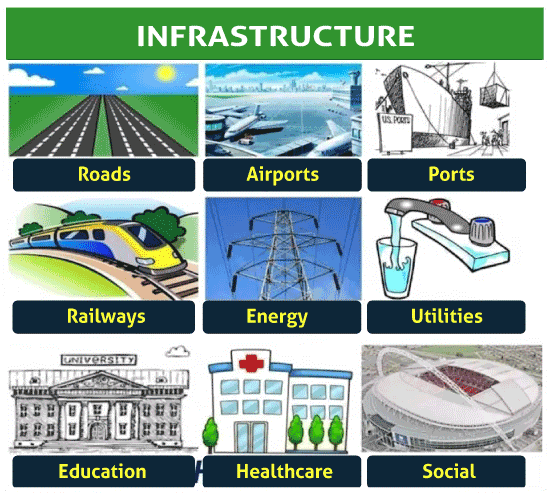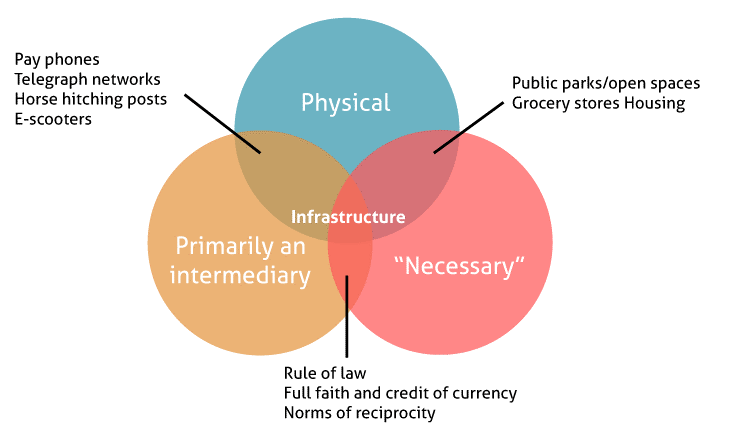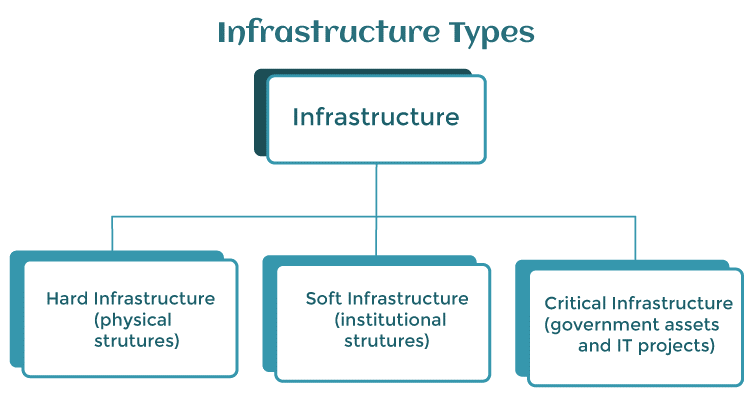Infrastructure DefinitionInfrastructure relates to the basic physical and organizational infrastructure required for a society or industry to function. Infrastructure in the context of technology often refers to the combination of software, hardware, and network components required to enable the operation of an information system. Depending on the situation, the meaning of infrastructure may differ. It can refer to everything from transportation networks and electricity grids to internet connection and cloud computing services in a wide sense. Infrastructure can also refer to the technological elements that underpin applications for software, such as server infrastructure, storage units, and networking equipment. Contemporary society and business rely on infrastructure to function. People and organizations would be unable to communicate, transport commodities, or obtain important services without proper infrastructure. The infrastructure is what helps organizations to offer digital goods and services to clients under the context of technology. Typically, specialized teams within organizations develop and manage infrastructure. These teams are in charge of making sure the system's components are installed, maintained, and secured effectively. They must also guarantee that the network is scalable and capable of dealing with fluctuations in demand. There has been a shift in recent years towards cloud-based infrastructure, in which organizations rely on third-party companies to maintain their IT infrastructure. This strategy can save money, boost scalability, and provide greater adaptability, but it also poses additional dangers linked to security and confidentiality of information. Overall, the notion of infrastructures is broad and includes both physical and organizational components. It is important to the operation of contemporary society and business, and infrastructure management is a specialized field that involves careful design, configuration, and maintenance. 
How Did Infrastructure Evolve?Infrastructure has changed dramatically over time as a result of shifts in society, technology, and the economy. Infrastructure can be tracked from ancient civilizations, when highways, waterways, and bridges were built to facilitate trade, transportation, and communication. Infrastructure development in the Middle Ages was primarily centered on fortified forts, walls, and other constructions for protection and defense. The Renaissance period saw the construction of infrastructural which included ports, canals, and highways, which permitted the movement of commodities and people across large distances. The nineteenth-century Industrial Revolution saw considerable developments in infrastructure, notably the building of railways, steamers, and telegraph lines. These advancements transformed communication and transportation, allowing people and products to move more rapidly and effectively than ever before. The twentieth century saw the development of modern infrastructure, such as motorways, airports in particular, and communication networks like the telephone & television. These advancements altered the way individuals lived and worked, allowing for increased mobility and connectedness across huge distances. With the exponential growth of internet access, computing via the cloud, and other technological advances in the last few years, the growth of digital technology has become a key priority. These advancements have changed the way individuals communicate, obtain knowledge, and do business, hastening globalization and interconnection. Overall, infrastructure progress has been influenced by a variety of variables, including technology advancements, economic growth, and sociological changes. Today, infrastructure is continually evolving, with fresh methods and technologies evolving to meet the demands of a fast-changing world. Importance of InfrastructureThe physical and organizational frameworks required for the delivery of important products and services are provided by infrastructure, which is critical to the operation of contemporary society and the economy. Here are some of the most essential reasons for infrastructure:
Infrastructure is critical for generating economic growth, improving quality of life, fostering social inclusion, promoting environmental sustainability, and assuring national security. Infrastructure investment is thus important for ensuring an abundant and future that is sustainable for all. 
Infrastructure More Important in Present GenerationBecause of the enormous alterations that have taken place around the world over the last few decades, infrastructure is more vital now than at any time before in the current age. Here are some of the reasons where infrastructure is so vital in today's generation: Technological Change at a Faster Pace: In recent years, the rate of technological progress has accelerated tremendously, with new technologies developing at an alarming rate. Infrastructure is required for sustaining these novel innovations, whether it is networks and data centers for cloud computing, charging stations for electric cars, or broadband networks for access to the internet at high speeds. Population Growth and Urbanization: The global population is expanding at a pace that is unprecedented, and urbanization is increasing. Infrastructure is required to support this rising population and to allow for effective movement of goods and individuals in and around cities. Aging Infrastructure: A large portion of the globe's infrastructure is ageing and in require repair or replacement. This infrastructure was often developed for another time period and is no longer adequate to fulfil contemporary needs. Investment in fresh and cutting-edge infrastructure is thus crucial to ensure that critical services are supplied efficiently and effectively. Climate Change: The Impact of Climate Change The impact of climate change has become one of the most important issues of our day, and infrastructure plays a critical part in tackling it. Building robust infrastructure that can resist the effects of severe weather, lowering emissions of greenhouse gases through environmentally friendly buildings, and assisting with the switch to energy from renewable sources are all key climate change mitigation measures. Globalization: The world has gotten more integrated, with global commerce and investment flows. Infrastructure is essential for sustaining these flows, whether it is ports and airports for global trade or communication networks for remote collaboration. Infrastructure is critical for meeting the current generation's difficulties and opportunities. Investing in modern, resilient infrastructure is important for creating a bright, long-term future for all. 
Types of InfrastructureThere are three major types of infrastructure, namely:
1. Hard InfrastructureThe material structures and facilities required to support social and economic operations are referred to as hard infrastructure. Transport networks, power plants, systems for water, and communication networks are examples of such systems. Hard infrastructure is essential for contemporary societies and the economy that sustain them to function. Hard infrastructure examples include:
Hard infrastructure is normally funded and built by the government, however private sector investment is permitted. Partnerships between the public and private sectors (PPPs) are becoming a prominent method of financing and constructing heavy infrastructure projects. Overall, concrete construction is necessary for modern communities and economies to function. Hard infrastructure investment can boost the economy, improve the standard of life, and increase social welfare. 2. Soft InfrastructureIntangible systems and structures that support both social and economic activity are referred to as soft infrastructure. Soft infrastructure, as opposed to hard buildings, which consists of building materials and facilities, encompasses things like educational systems, legal structures, and social networks. Soft infrastructure is critical to the operation of contemporary cultures and economies, and it is frequently regarded as a fundamental driver of economic expansion and progress. Soft infrastructure examples include:
Although investment from the private sector may be engaged, soft infrastructure is frequently sponsored and supplied by the public sector. Soft infrastructure systems must be built and managed to fulfil the requirements of individuals and communities, therefore efficient policy and governance are crucial to their success. Soft infrastructure is critical to the operation of modern communities and economies. Soft infrastructure investment can boost growth in the economy, improve the standard of life, and increase social welfare. 3. Critical InfrastructureThe physical and cyberspace resources, networks, and connections that are critical to the running of economies and societies are referred to as critical infrastructure. These resources and structures are deemed important because failure or interruption would have serious consequences for the public's safety, health, security, & economic well-being. Critical infrastructure comprises an extensive variety of industries and sectors that include both soft and hard infrastructure. Critical infrastructure examples include:
In many nations, critical infrastructure is regarded as a matter of national safety priority and is subject to government regulation and oversight. Partnerships and collaborations between the public and private sectors are also vital for the building and upkeep of critical infrastructure, as the private and public sectors play important roles in guaranteeing their resilience and safety. In general, critical infrastructure is crucial to the operation of modern societies and the economy, and its resilience and security are critical to the preservation of public health, security, safety, and economic well-being. 
Selection CriteriaThere are numerous crucial characteristics that politicians and investors should examine when choosing projects for infrastructure to invest in. These criteria can assist guarantee that infrastructure investments maximize the social and economic advantages while minimizing potential risks and negative consequences. Some of the most important selection factors for infrastructure investments are:
Infrastructure projects require continuing maintenance and operation to guarantee that they'll continue to provide the intended advantages in the long run. When selecting infrastructure projects, sponsor ought to think about the costs and demands of ongoing operations and maintenance. Policymakers and investors may ensure that infrastructure projects generate the greatest social and economic advantages while minimizing risks and adverse consequences by carefully evaluating these selection criteria. This can serve to foster sustainable economic growth and improve people's quality of life all around the world. Advantages of InfrastructureHere are a few of the benefits of infrastructure:
To summarize, infrastructure is crucial for the running of a contemporary society and provides several benefits such as economic growth, increased quality of life, sustainable development, security for the nation, resilience, and innovation. Disadvantages of InfrastructureWhile infrastructure provides many benefits, it also has certain drawbacks, which include:
To summarize, while infrastructure has many benefits, it is critical to understand the potential drawbacks and seek to limit them through careful preparation, design, and implementation. Applications of InfrastructureInfrastructure has numerous uses in various areas and industries. Here are a couple such examples:
Finally, infrastructure is critical in many areas and businesses, sustaining growth in the economy, the well-being of the public, interaction, learning, security and safety of the public, and many other things. ConclusionFinally, infrastructure is an essential component of modern civilization, laying the groundwork for economic progress, the well-being and health of the public, interaction, learning, and security and safety for all. Transportation, electricity, sanitation and water supply, interactions, medical care, & public safety infrastructure are critical for ensuring society's smooth operation and meeting the requirements of people and their neighborhoods. While infrastructure provides many benefits, it also has certain drawbacks, such as high costs, environmental damage, social and economic inequalities, and maintenance difficulties. As a result, it is critical to carefully organize, create, and carry out infrastructure projects, taking into account potential consequences and attempting to reduce any negative effects. Investment in infrastructure is critical for developing flexible, environmentally friendly, and equitable societies capable of overcoming current difficulties and preparing for the future.
Next TopicIntrovert Definition
|
 For Videos Join Our Youtube Channel: Join Now
For Videos Join Our Youtube Channel: Join Now
Feedback
- Send your Feedback to [email protected]
Help Others, Please Share










